What is House Wrap & Siding Foam Board? The Energy Efficient Superheros with Moisture-Proof Power
housewrap foam board siding
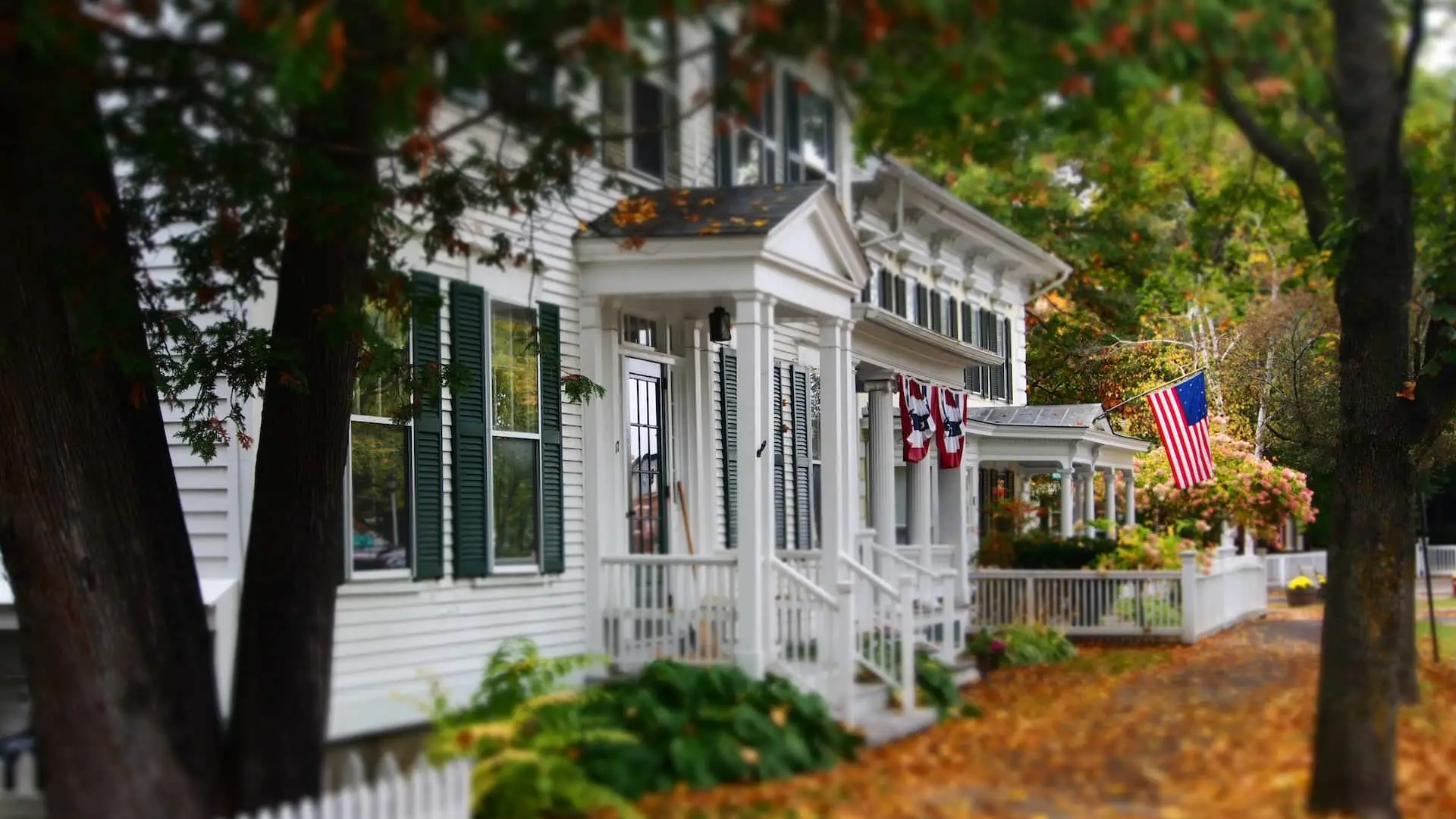 New England’s weather takes a toll on your home’s exterior. An extra weatherproof barrier can bring many benefits to your home, especially during New England’s wet and soggy autumn season.
At Coastal Windows & Exteriors, we always strip a home when we install vinyl siding as we need to check for any rot and leaks. Our New England homes need all the help they can get with defending against the harsh weather elements.
This is when products like house wrap and siding Progressive foam board enter the picture which provides excellent protection against moisture, prevents water penetration and actually channels water away from your home, while providing a breathable barrier technology for many years.
Think of it as the evolution in water drainage, beathabilty & durability…It’s the exterior upgrade that you never knew you needed!
But what is house wrap and its super sidekick, siding foam board?
New England’s weather takes a toll on your home’s exterior. An extra weatherproof barrier can bring many benefits to your home, especially during New England’s wet and soggy autumn season.
At Coastal Windows & Exteriors, we always strip a home when we install vinyl siding as we need to check for any rot and leaks. Our New England homes need all the help they can get with defending against the harsh weather elements.
This is when products like house wrap and siding Progressive foam board enter the picture which provides excellent protection against moisture, prevents water penetration and actually channels water away from your home, while providing a breathable barrier technology for many years.
Think of it as the evolution in water drainage, beathabilty & durability…It’s the exterior upgrade that you never knew you needed!
But what is house wrap and its super sidekick, siding foam board?
what is a house wrap
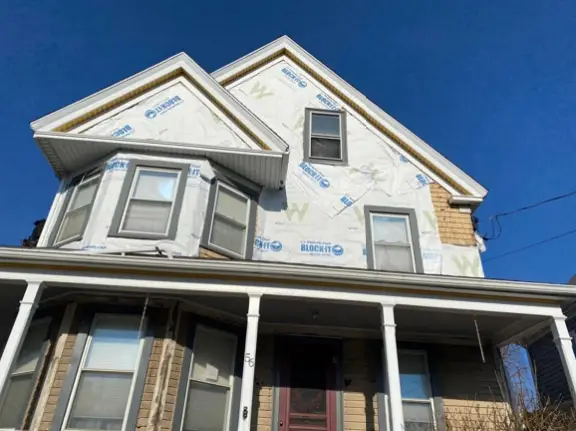
What is House Wrap? A Simple Description
House wrap by Block-It serves as an additional shield to the elements. It wraps around your home and serves to keep moisture out, including snow. This is primarily used during the vinyl siding installation process. Serving as a breathable barrier, it allows water vapor and air to pass through while blocking water from entering your home. House wrap is constructed from synthetic material. It’s lightweight, non-woven, and resists tears or punctures.It even self- seals around nails, meaning water will NOT infiltrate through openings. Yes, House Wrap is your best friend! Its got your back through and through!What Does House Wrap Do?
This is the most exciting part about house wrap! Serving as an essential layer with vinyl siding installation, it offers a myriad of protective upgrades for your home. Think of house wrap as closing up the box. It covers the exterior of your home while being installed around windows and doors. When you add house wrap to your home, this is what you can expect in terms of performance.- Exclusive Patented Water Channeling Technology: Directs water away from the wall assembly to the ground. Passes ASTM Drainage tests which provides premium performance.
- Highly Durable Materials: Provides 20% greater water holdout than Tyvek and also 40% stronger. This is superior weatherization for your home!
block it house wrap
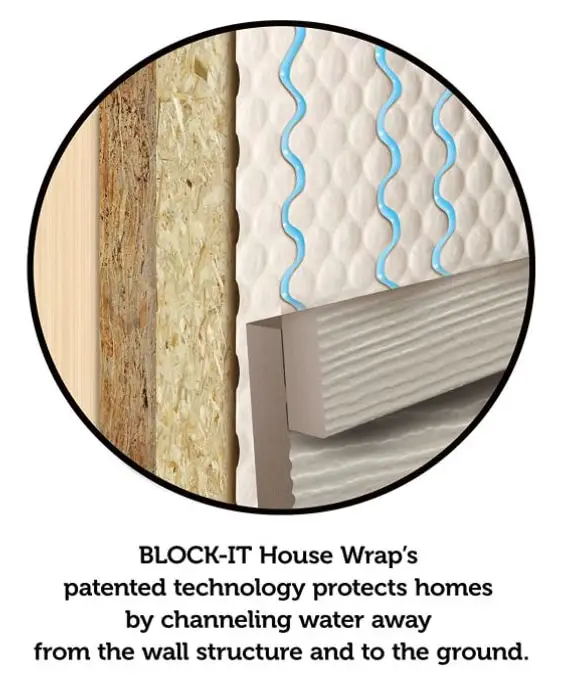
House Wrap Prevents Moisture Damage
The primary purpose of house wrap is to prevent wind-driven rain and moisture from penetrating from reaching the sheathing and internal damage to your home. It assists with maintaining a dry building structure.exterior product with weatherproof
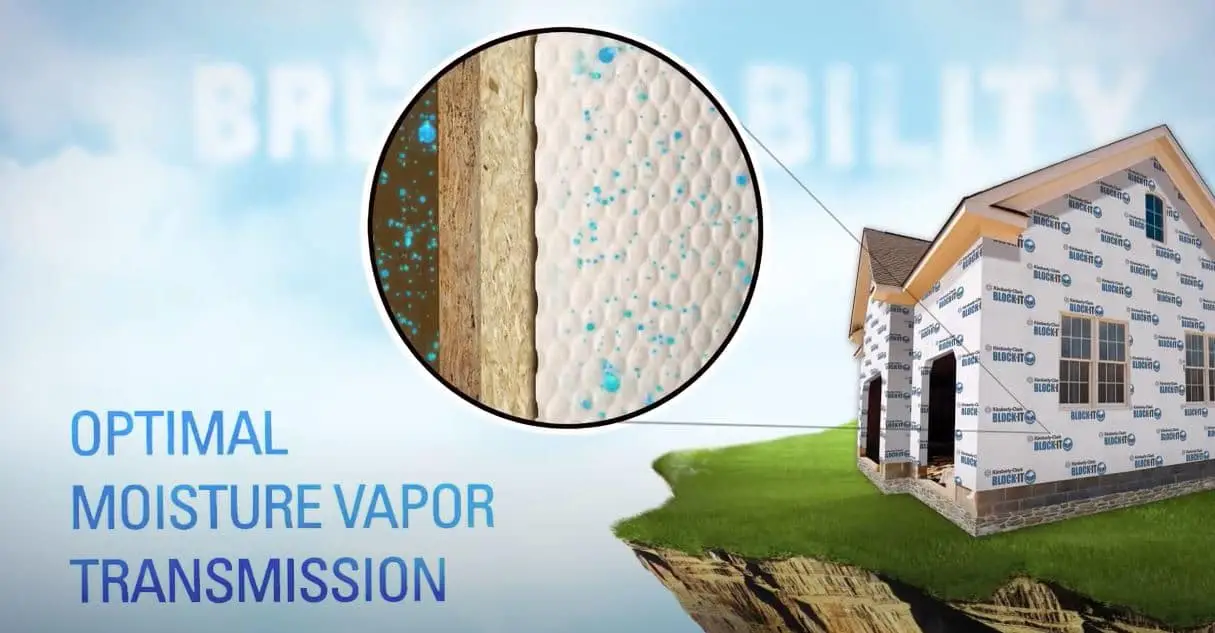 This is important because moisture can be incredibly dangerous and damaging to your home.
For example, moisture can deteriorate wood siding. When the wood is exposed to moisture without treatment, it can even lead to rotting wood.
With house wrap applied to your siding, you will have a weatherproof and waterproof barrier for incredible protection. In fact, house wrap is essentially the #1 defense mechanism. House wrap ensures that you have protection no matter the circumstances.
This is important because moisture can be incredibly dangerous and damaging to your home.
For example, moisture can deteriorate wood siding. When the wood is exposed to moisture without treatment, it can even lead to rotting wood.
With house wrap applied to your siding, you will have a weatherproof and waterproof barrier for incredible protection. In fact, house wrap is essentially the #1 defense mechanism. House wrap ensures that you have protection no matter the circumstances.
House Wrap Prevents Mold
Mold is perhaps the most concerning aspect of moisture damage. Not only is it unsightly, but it is also damaging to your exterior. In the worst-case scenarios, it can lead to health issues. House wrap prevents mold by ensuring that moisture can’t reach the exterior. Moisture is one of the key elements that mold needs to grow and flourish. The vapor-permeable membrane allows moisture in the home to escape, protecting your home from rot and mold.House Wrap Reduces Drafts
When you’re dealing with a drafty home, it can cause your home to feel cold and uncomfortable. The protective layer of house wrap keeps drafts out and can serve as a barrier against lost energy. This air barrier helps reduce your heating & cooling costs!house-wrap-1
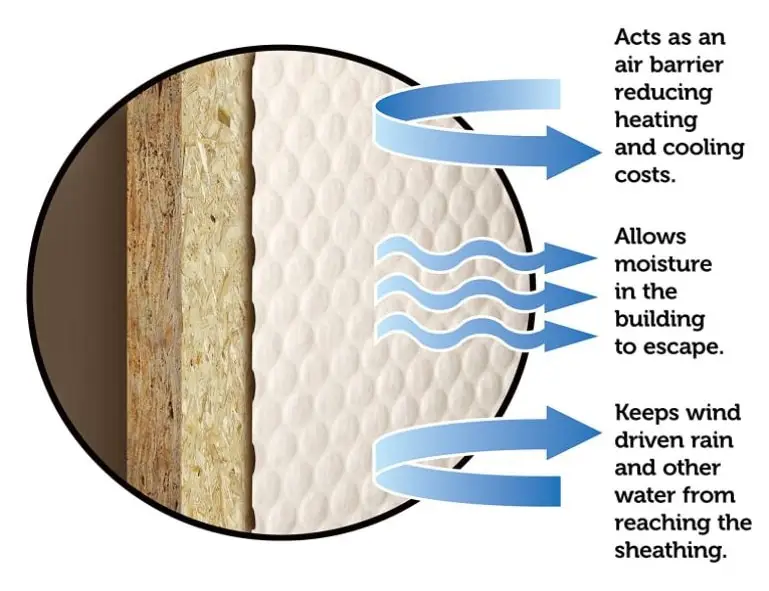
Is House Wrap Necessary?
The best approach is to have your house wrap installed before your new vinyl clap siding or vinyl cedar shakes. This way you can be sure that your home is receiving proper protection. As Kimberly-Clark says, Don’t just wrap your home, BLOCK it against the elements! As you can see, house wrap is necessary to prevent damage such as the following: Prevention from mold that results from contact with moisture. Moldy siding will break down the structure of your siding and leave the exterior exposed.moldy siding
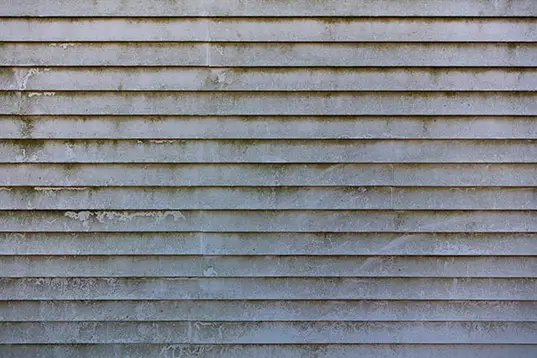 Image Source: Unsplash
Image Source: Unsplash
-
- It keeps your exterior otherwise protected if the vinyl becomes damaged. If wood is exposed to the elements, it’s subject to chipping, peeling, and rot.
- House wrap also reduces drafts and helps your family feel comfortable no matter the time of year.
- Bottom Line: It prevents the penetration of water and channels water away from your home, while providing a breathable barrier that protects your home for years to come!
siding exterior damage
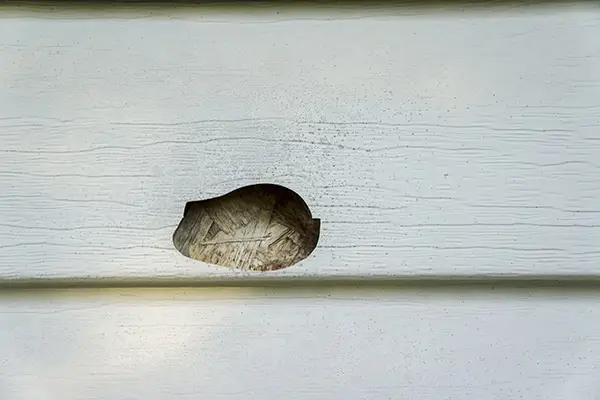 That’s a wrap on what you need to know about house wrap! Next, let’s explore the benefits of siding foam board.
That’s a wrap on what you need to know about house wrap! Next, let’s explore the benefits of siding foam board.
The RIGHT Way to Install New Siding…with Foam Back Insulation?
In the most energy-efficient options of the vinyl exterior, Progressive foam siding is installed under the panels for moisture control and many other advantages. Foam siding is engineered to reduce heat transfer, resulting in energy savings and a durable layer against unexpected impact to your siding. With a 1-inch layer of foam siding under your vinyl, you can receive an immediate increase in R-value of 5. Meanwhile, air infiltration is blocked within the wall cavity for additional comfort. HINT: The more insulation that fits behind your siding the higher the R-Value. It’s the most cost-effective time to add insulation to your home’s exterior…when you reside in your home with vinyl siding…do it right the first time and enjoy the benefits for years to come. Vinyl siding with foam back insulation ensures you will get the most from your new siding: premium appearance, improved durability & energy savings.Can Siding Progressive Foam Board Save Energy?
There may be an energy leak in your walls that is costing you money every day! Did you know that 35% of your home’s energy is lost through the wall studs? This primarily happens when the walls are uninsulated, making it easy for energy loss via heat transfer. If 35% of your home’s walsall is made up of uninsulated studs, that is like having one entire wall of your home with NO insulation!wall studs
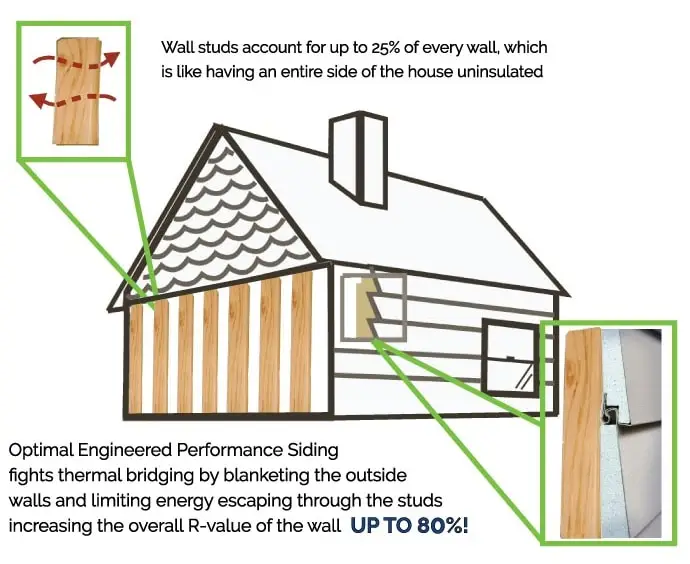 Heat bypasses the insulation in your wall cavity and transfers through the studs, allowing energy to leak through your walls. This energy loss is known as thermal bridging, which affects New England homes in the summer as well as the winter.
Heat bypasses the insulation in your wall cavity and transfers through the studs, allowing energy to leak through your walls. This energy loss is known as thermal bridging, which affects New England homes in the summer as well as the winter.
energy loss in a home
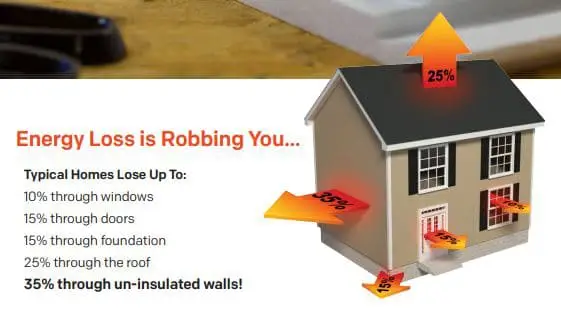
- In the winter, heat leaks through the walls where cavity insulation settles and loses the effectiveness of keeping the home warm.
- During the summer, heat from the outdoors leaks through the studs which results in the air conditioning system working harder to keep the home cool.
Exterior product with Weatherproof
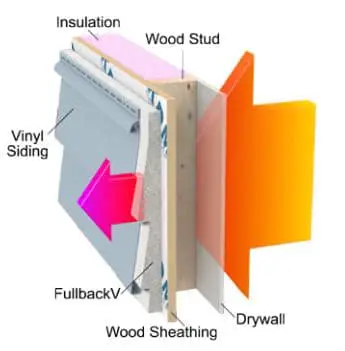
Bottom Line: Provides real energy savings by keeping heat where it belongs, inside in the winter, outside in the summer and money in your bank account all year!
Foam Siding Protects Your Home From Moisture Damage And Your Health & Comfort
House wrap helps prevent moisture damage, but when coupled with foam siding they create an unstoppable force.Exterior product with Weatherproof foam siding protection
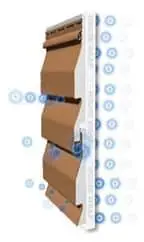
- Moisture Management System for your home: It’s estimated that each person uses 80-100 gallons of water per day at home. Instead of that moisture becoming trapped inside the home, foam can help it escape. Foam back siding is designed to shed water and allow walls to completely dry with a permeability rating up to 5.0, reducing the chance of mold & mildew growth in your walls.
- Prevent Against Termite Damage: Our foam insulation exterior product with weatherproof is treated with a safe insecticide that protects your home from termite damage. Most people don’t know they have a problem until it’s too late. Rest assured and have peace of mind as this product not only saves energy but it protects your home from future termite damage. In other leading brands, or when a home does not have any foam back protection, termites and other insects will create tunnels and damage the structure of your home. This treated foam doesn’t just repel the insects its kills the BEFORE they can inflect any damage.
Don’t Let Water Get Trapped In Your Walls
Moisture cannot remain inside your home for several reasons. These reasons are vital to your health as well as the overall condition of your home. Adding insulation to home reduces energy loss, but it can also create moisture problems so make sure water vapors don’t get trapped in your walls.water damage
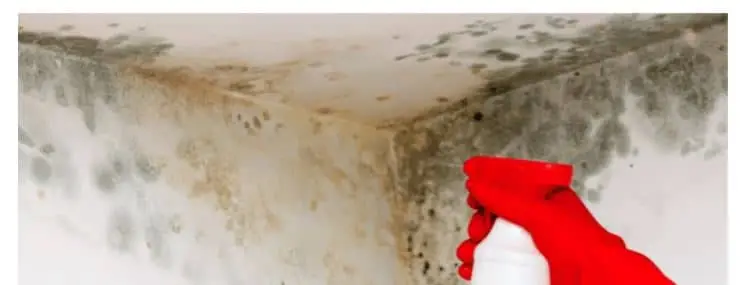
- Built-up moisture inside the home can lead to mildew and mold growth. In the worst cases, black mold can form which is incredibly comprising to your health.
- If the moisture problem is neglected, the structure of the home can suffer. This is because moisture damage leads to wood rot in the home’s frame.
- Choose a foam with a Stay Dry technology (5x more breathable than other products) that actually releases water vapor to the outside of your home where it belongs.
Get The Best Appearance & Noise Protection
Did you know that exterior product with weatherproof when you install foam back siding it not only provides energy-efficiency to your home with thermal bridging, and protect your home from water damage, it provides additional support to the siding panel giving your home the look and feel of real wood (wood vs vinyl siding) and eliminates waving, sagging and warping.vinyl siding protection
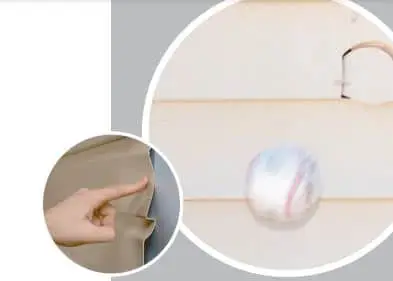 It helps maintain the shape over time and protects from impact damage. Gives your home that curb appeal you dream of! Check out the video below to see how strong it is!
Added Comfort…With this new energy-saving blanket to your home you can enjoy more consistent indoor temperatures from room to room. No more saying, why is this room so cold?
It helps maintain the shape over time and protects from impact damage. Gives your home that curb appeal you dream of! Check out the video below to see how strong it is!
Added Comfort…With this new energy-saving blanket to your home you can enjoy more consistent indoor temperatures from room to room. No more saying, why is this room so cold?
siding foam protection
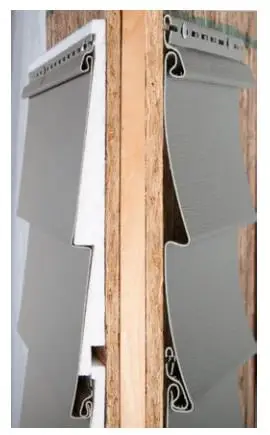 Also reduce sound transmission by up to 39% making your home more quiet and comfortable.
Also reduce sound transmission by up to 39% making your home more quiet and comfortable.
Moisture-Proof Your Home with House Wrap & Progressive Foam Siding
If you’re a New England homeowner, it’s critical to include both house wrap and foam siding. You need them for:- Waterproof protection
- Exterior product with Weatherproof
- Defending against mold, mildew, and rot
- Allows your home to breathe
- Maintain structural integrity
- Protects against termite damage
- Save money on your energy bills
- Have a safe, healthy comfortable home…for a lifetime!




